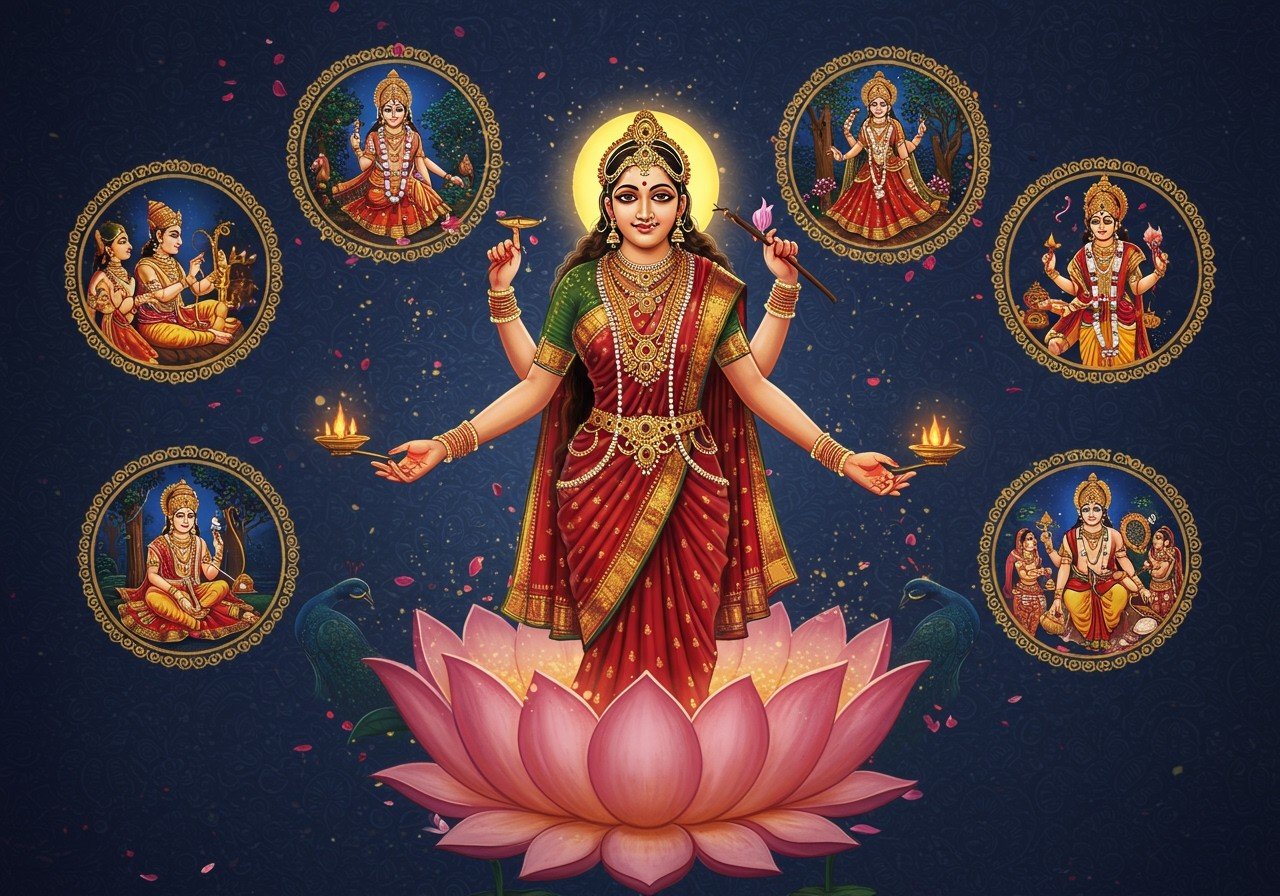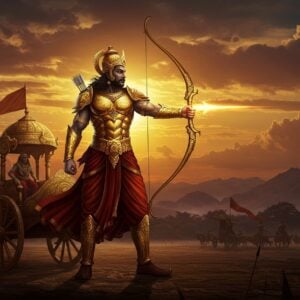
In Indian culture, the Ramayana holds a special place as one of the greatest epics. Sita’s story within it is a powerful tale of virtue, devotion, and resilience. By exploring her journey beyond traditional narratives, we uncover deeper themes of loyalty, sacrifice, and duty. Understanding Sita’s role in the Ramayana helps us appreciate her impact on society and her timeless relevance. At poojn.in, we understand the significance of Sita Mata in Hindu mythology and offer a wide range of puja samagri to honor her. Explore our collection of divine idols and samagri to enhance your spiritual practices.
Sita in the Ramayana
Sita’s character in the Ramayana is unique and compelling. Born from the Earth Goddess, Bhūmi, her divine origins set her apart. Her marriage to Lord Rama followed a grand swayamvara, marked by the breaking of Shiva’s Dhanush. This act of strength foreshadowed the resilience she would display throughout her life. During Rama’s exile, Sita’s support and dedication were unwavering, showcasing her deep love and commitment. Despite being abducted by Ravana, she maintained her faith and inner strength in Lanka, refusing to yield to his advances. Her interactions with Hanuman and her ultimate return to Ayodhya, where she faced the Agni Pariksha, demonstrate her unwavering resilience and purity. Explore more about the characters and lessons from Ramayana here.
Sita and Hanuman
In the heart of the Ramayana lies the extraordinary connection between Sita and Hanuman. This relationship transcends a simple meeting; it embodies faith, courage, and hope. As Sita endured captivity in Ashoka Vatika, Hanuman appeared as a symbol of hope, a divine messenger sent to reassure her. He wasn’t merely a messenger; he was a protector, a symbol of divine intervention and the power of devotion. Their encounter in Ashoka Vatika is deeply significant. When Hanuman presented Rama’s ring, it was a promise of freedom, a testament to their enduring bond. Sita, in return, entrusted Hanuman with her Chudamani, an act of faith and a symbol of hope for divine justice. Hanuman’s courage, fueled by devotion, played a pivotal role in Sita’s rescue, reminding us of the power of faith and the belief in a higher purpose. Learn more about the symbolism and teachings in the epic Ramayana here.
Why Sita Left Ram
The narrative of Sita’s departure from Rama is layered with complexity and emotion. Even after proving her purity, whispers and rumors continued to circulate, casting a shadow over her. Rama, as king, faced immense pressure to uphold societal expectations, a conflict that tore at his personal relationships. Despite the deep pain it caused, he felt compelled to exile Sita, a decision driven by duty and societal pressures. From Sita’s perspective, leaving was an act of preserving her dignity and integrity. She chose the solitude of the forest over a life tainted by doubt. At Sage Valmiki’s hermitage, she found refuge and raised her sons, Lava and Kusha. Her life in exile reflects themes of sacrifice, resilience, and the strength to uphold one’s values in the face of adversity. Delve deeper into the enduring influence of the Ramayana on Indian culture here.
Sita’s Legacy
Sita’s legacy remains a powerful embodiment of feminine strength and resilience. Across generations, she has shaped ideals of womanhood, influencing societal values and inspiring countless individuals. In various adaptations of the Ramayana, Sita’s reverence endures, demonstrating her timeless appeal. Her story continues to spark discussions on gender roles, morality, and ethics, prompting reflection on societal expectations and the challenges women face. Sita’s choices and resilience continue to resonate, offering lessons in love, duty, and the strength to navigate complex situations with grace and integrity. Understand more about the Ramayana and its timeless lessons for modern life here.
How Poojn.in Helps You Honor Sita Mata’s Legacy
Poojn.in offers a curated selection of puja items to connect you with the sacred story of Sita Mata. Enhance your devotion with our authentic collection:
- Pure cotton vastras: Available in red and white, colors traditionally associated with Sita Mata, these vastras add a touch of authenticity to your puja.
- Traditional kumkum and haldi: Essential for shringar offerings, these symbolize auspiciousness and purity.
- Brass and copper deepams: Illuminate your aarti ceremonies with beautifully crafted deepams, creating a sacred atmosphere.
- Natural incense sticks: Made with traditional ingredients, our incense sticks enhance the spiritual ambiance of your puja.
- Pure ghee: For deepam lighting, our pure ghee ensures a traditional and sacred offering.
- Tulsi mala and beads: Use these for japa and meditation, connecting with the divine energy of Sita Mata. You can buy a Tulashi Herbal Taral Alta from our website.
- Copper and brass kalash: An integral part of many rituals, our kalash are crafted with care and reverence. You can also buy a Pure Cotton Saree from our website for the goddess.
We deliver these sacred items across India, ensuring they reach your doorstep with convenience. Each product comes with clear instructions in multiple languages for ease of use. Our rigorous quality control guarantees pure, ritual-grade items perfect for your worship. For bulk orders for temple events or community pujas, our dedicated team offers personalized assistance. All items are packaged with utmost care to preserve their sanctity during transit. Visit www.poojn.in or contact our customer service for guidance on selecting the right puja items. We are committed to supporting your traditional worship practices with authenticity and convenience.
Embracing Sita’s Lessons
Sita’s journey, interwoven with the epic Ramayana, offers enduring lessons in faith, courage, and resilience. Her connection with Hanuman underscores the power of devotion and the divine guidance that sustains us through trials. Sita’s decision to leave, motivated by her unwavering integrity, showcases the sacrifices we make for our values. As we continue to explore her legacy, Sita inspires us with her strength and embodiment of feminine power. Her narrative encourages reflection on the role of women in society, the balance between love and duty, and the enduring challenges women face. Through Sita’s story, we discover hope, inner strength, and inspiration to embrace courage and faith in our lives. Learn about the strength and modern relevance of Ramayana women here.
FAQs About Sita’s Story: An Exploration
Who is Sita in the Ramayana? Sita, also known as Siya, Janaki, and Maithili, is the wife of Lord Rama and a central figure in the epic. Revered as a goddess, she’s considered an incarnation of Goddess Lakshmi. Her story embodies love, sacrifice, courage, purity, and unwavering loyalty.
What is Sita’s significance in the Ramayana? Sita embodies virtue and righteousness. Her journey highlights patience, loyalty, and courage, teaching us to stand strong amidst adversity. Her story continues to resonate today, inspiring reflections on love, duty, sacrifice, and the challenges women face in society. Find out who wrote the Ramayana and understand its authorship and origins here.
How did Sita and Hanuman meet? Their first encounter was in Lanka, where Hanuman, Rama’s devoted servant, found Sita imprisoned by Ravana. He brought her a message of hope, assuring her of Rama’s impending rescue, strengthening her spirit during captivity.
Why did Sita leave Rama? To protect her honor and uphold his kingdom’s reputation, Rama asked Sita to undergo a trial by fire. Though she proved her purity, later rumors and societal pressures led to her exile, a choice she made to preserve her dignity and raise her sons in peace.
What lessons can we learn from Sita’s story? Sita’s life exemplifies resilience, self-respect, unwavering devotion, and courage in challenging times, inspiring us to uphold our values and face difficulties with grace. Explore the cultural impact of the Ramayana across ages here.
How does Sita’s story end? After repeatedly demonstrating her purity, Sita chose to return to Mother Earth, her birthplace, a final affirmation of her virtue and a symbolic liberation, reuniting her with the divine.
Is Sita’s story relevant today? Sita’s story remains deeply relevant, emphasizing timeless values like integrity, loyalty, and strength, inspiring us to face life’s challenges with honor and grace. Discover the various Ramayana festivals and how they celebrate ancient traditions here.


